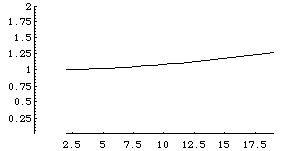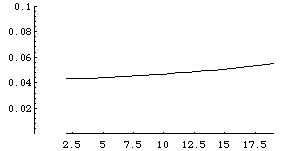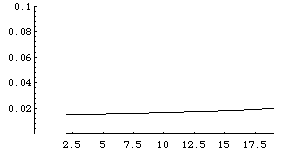
[ T-quark mass (ratio with T-quark low-energy mass 130 GeV) vs. log(energy GeV) ]

[ B-quark mass (ratio with T-quark low-energy mass 130 GeV) vs. log(energy GeV) ]

[ Tauon mass (ratio with T-quark low-energy mass 130 GeV) vs. log(energy GeV) ]
The lowest order renormalization group equations for the Yukawa couplings in the F4 model can be studied by using Mathematica:

[ T-quark mass (ratio with T-quark low-energy mass 130 GeV) vs. log(energy GeV) ]

[ B-quark mass (ratio with T-quark low-energy mass 130 GeV) vs. log(energy GeV) ]

[ Tauon mass (ratio with T-quark low-energy mass 130 GeV) vs. log(energy GeV) ]
The variables c (and cc), w, and e (and ee) are the color, weak,
and electromagnetic charges, using the unconventional convention that
a = g^2 rather than a = g^2/4¹ for charge g.
The conventional renormalization equation is of the form
MdC / dM = - 7C^3/16¹^2, with C^2/4¹ = ac, so that C = (Ãac)(2ù).
If c^2 = ac, then C = c 2ù so that Md(2ùc) / dM = - 7 x 8¹Ã¹c^3 / 16¹^2, so the lowest order renormalization equations are then:
Mdc / dM = -7c^3/4¹ ; Mdw / dM = -3.3w^3/4¹; and Mde / dM = +4e^3/4¹ .
Since Md / dM = d / dlnM = d /2.3logM , where M is the mass-energy scale, a conversion factor from ln to log is needed for plotting graphs against logM.
The variables t, b, and lt are the Yukawa coupling charges for the massive third generation fermions: the truth quark, the beauty quark, and the tau lepton. The unconventional convention a = g^2 is used here, as it is used throughout this paper.
The F4 model predicts that the total first generation Yukawa coupling Y1 is given by Y1 = e^2/w = 0.0146 = 1/68.5 .
Y1 is described by Y1 = (ur, ug, ub, dr, dg, db, e, ñ) , where the value
Y1 = e^2/w is given by
Y1 = e^2/w = Tr(Y1) = ur + ug + ub + dr + dg + db + e + n .
Since the neutrino is massless, the Yukawa coupling n = 0. Since the red, blue, and green quarks have the same mass, u = ur = ug = ub and
d = dr = dg = db and Y1 = 3u + 3d + e.
For the third generation, Y3 = 3t + 3b + lt.
With respect to the Yukawa couplings, it is useful to recall that the sums of the fermion masses (including both particles and
antiparticles and both Dirac helicity states) for the three generations are:
Smf1 = 7.508 GeV;
Smf2 = 32.94504 GeV; and
Smf3 = 1,629.2 GeV.
Since the third generation fermions have total mass 1,629.2 GeV, rather than the first generation fermion total mass 7.508 GeV,
Y3 = (1,629.2 / 7.508) e^2 / w Å 217 e2/w = 217 / 68.5 Å 3.16.
The lowest order renormalization group equations (ignoring effects of Yukawa couplings weaker than t) are:
Mdt / dM = {[ t3 - (2.67c2 + 1.5w2 + 0.72e2) t] /4¹}/4¹ ;
Mdb / dM = {[ b t2 - (2.67c2 + 1.5w2 + 0.39e2) b ]/4¹}/4¹ ; and
Mdlt / dM = {[ lt t2 - ( w2 + 1.5e2) lt ]/4¹}/4¹ .
The second 1 / 4¹ factor is added because Yukawa coupling are based on two forces, the electromagnetic and the weak. There is a t2 term for lt as well as t and b because in the F4 model lt, t, and b all come from triples of the same half-spinor representation of Spin(8).
The truth quark Yukawa charge t takes the values 1.0 at 100 GeV and 1.1 at 10^19 GeV. The F4 model predicts that t = (130 / 412.5)Y3 = 1.0 at the 100 GeV characteristic energy for the SU(2) weak force, since 130 GeV is the truth quark mass and 412.5 is the sum of the masses of the third generation fermion particles (as opposed to antiparticles) of a given Dirac helicity.
The beauty quark Yukawa charge b takes the values 0.043 at 100 GeV and 0.054 at 10^19 GeV. The F4 model predicts the value b = (5.6 / 412.5)Y3 = = 0.043 at the 100 GeV characteristic energy for the first generation SU(2) weak force, since 5.6 GeV is the beauty quark mass and 412.5 is the sum of the masses of the third generation fermion particles (as opposed to antiparticles) of a given Dirac helicity.
The tau lepton Yukawa charge lt takes the values 0.015 at 100 GeV and 0.019 at 10^19 GeV. The Fð [ F4 ] model predicts the value lt = (1.9 / 412.5)Y3 = 0.015 at the 100 GeV characteristic energy for the first generation SU(2) weak force, since 1.9 GeV is the tau lepton mass and 412.5 is the sum of the masses of the third generation fermion particles (as opposed to antiparticles) of a given Dirac helicity.